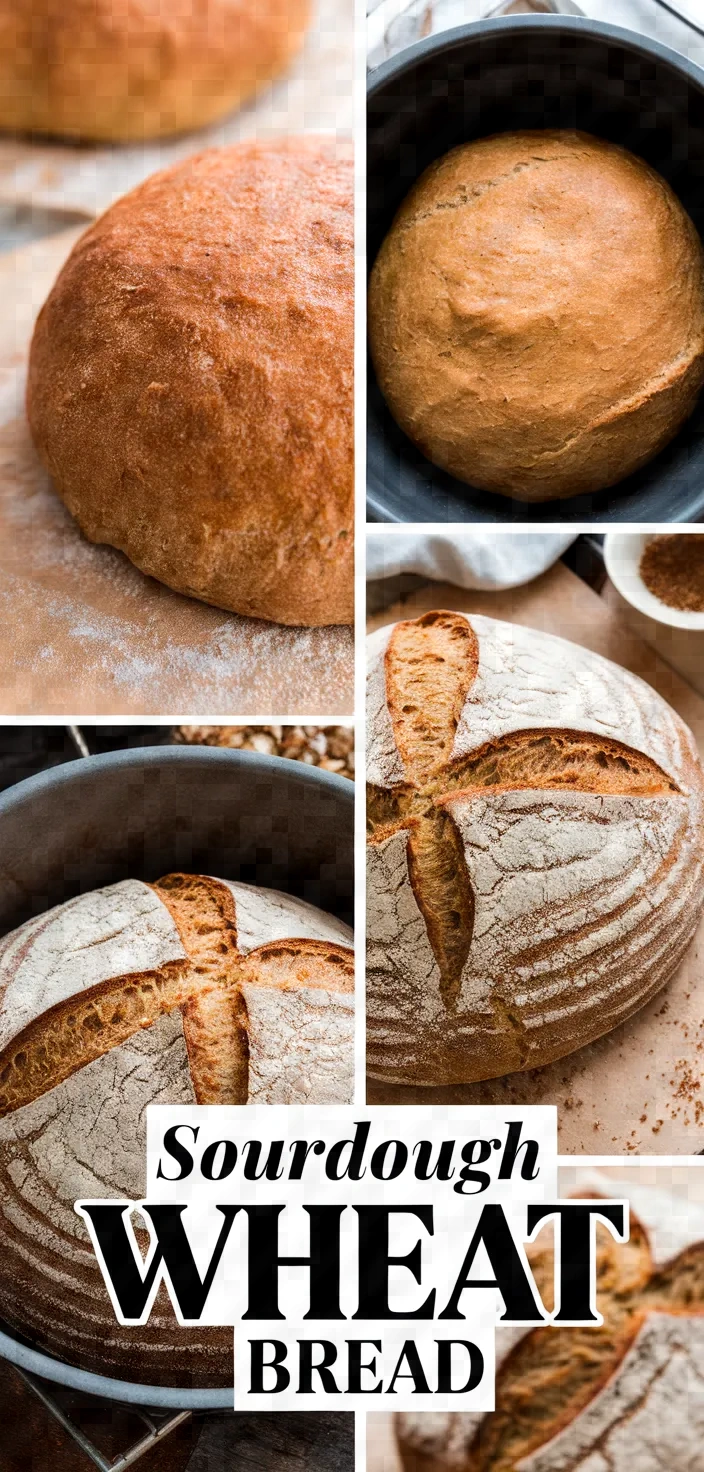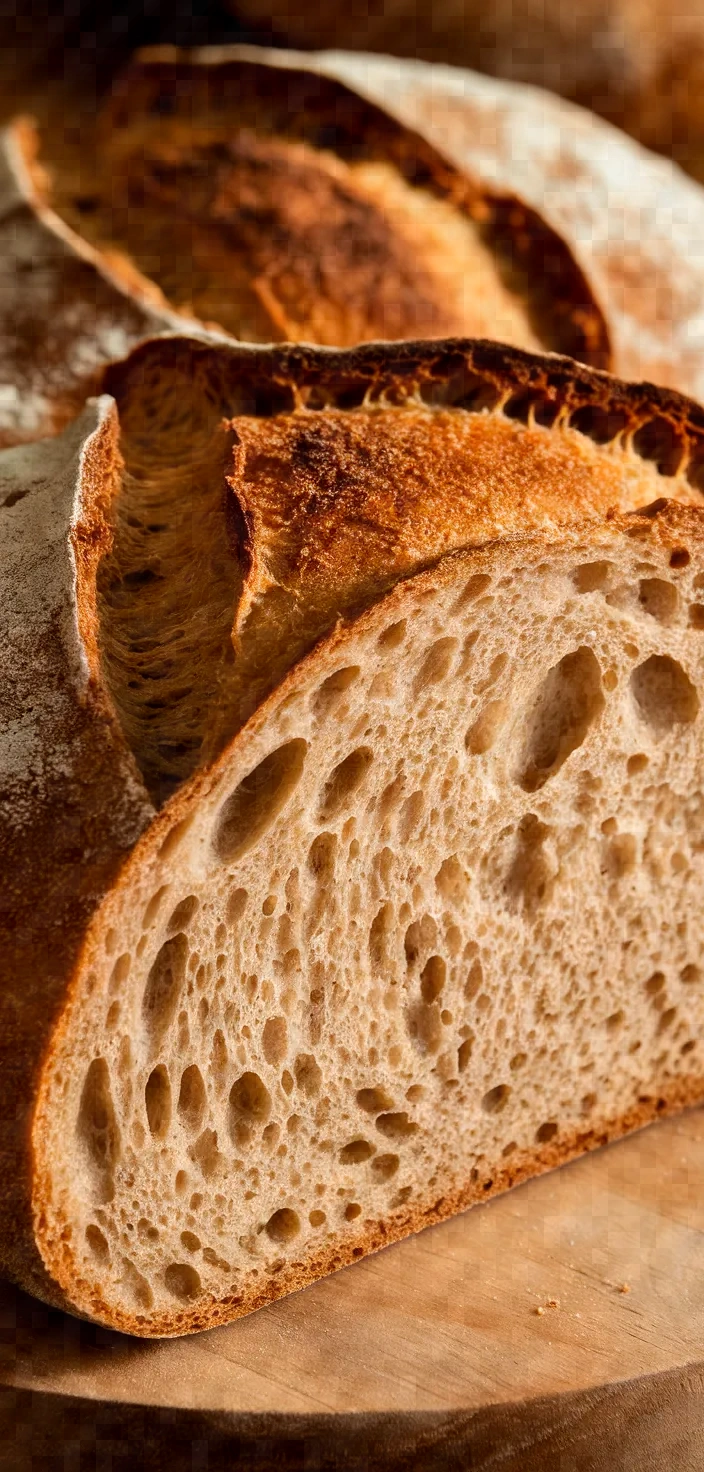Ever wondered what magic happens when you let a humble starter meet honey and olive oil in a dance of warmth and time? Let me take you on a journey to create the most wholesome, heartwarming sourdough loaf that will fill your kitchen with the aroma of pure love and satisfaction.

I enjoy making recipes that strike a balance between flavor and nutrition. My Sourdough Whole Wheat Bread is just that.
Using a cup of active sourdough starter along with the deep flavor of whole wheat flour, this bread is a fantastic source of fiber. Drizzling in some honey gives the bread a hint of sweetness while still remaining 100% wholesome.
Ingredients

- Active Sourdough Starter: Contains natural yeast and bacteria, aids fermentation.
- Whole Wheat Flour: High in fiber, adds nutty flavor and nutrients.
- Warm Water: Activates yeast, creates dough’s base structure.
- Honey or Sugar: Feeds yeast, adds sweetness and browning.
- Olive Oil: Adds moisture, contributes to a tender crumb.
- Salt: Enhances flavor, strengthens gluten structure.
Ingredient Quantities
- 1 cup (240g) active sourdough starter
- 1 1/2 cups (360ml) warm water
- 2 tablespoons (25g) honey or sugar
- 3 tablespoons (45ml) olive oil
- 3 1/2 cups (420g) whole wheat flour
- 1 cup (120g) all-purpose flour
- 2 teaspoons (10g) salt
How to Make this
1. In a big mixing bowl, mix the warm water and the active sourdough starter. Stir until the starter is predominantly dissolved.
2. Include the honey (or sugar) and olive oil in the mixture and stir thoroughly until completely combined.
3. Slowly mix in the whole wheat flour and the all-purpose flour, in that order. When the shaggy dough forms, stop mixing and cover the bowl with plastic wrap; let the dough rest for 30 minutes.
4. Sprinkle the salt onto the dough and mix until the salt is evenly distributed.
5. Place the dough onto a surface dusted with flour and work the dough for about 8 to 10 minutes until it takes on a smooth, elastic texture. You can use a stand mixer outfitted with a dough hook if you’d prefer not to do it by hand.
6. Put the dough that has been kneaded into a bowl that has been lightly oiled. Cover the bowl with a damp cloth or plastic wrap. Allow the dough to rise at room temperature for 4-5 hours or until it has doubled in size.
7. When the dough has risen, gently deflate and shape it into either a round or oval loaf. Your preference will determine which of these options you choose.
• Deflate the dough.
• Shape the dough into a round or an oval loaf.
8. Put the molded dough onto a baking sheet that has been lined with parchment or into a bread pan that has been greased. Put a covering over it and let it rise for 2 to 3 hours more, until the dough is and looks puffy and has risen a good amount.
9. Heat your oven to 425°F (220°C). If you wish, you can place a shallow pan of water on the bottom rack to create steam for a crustier loaf.
10. Score the top of the loaf with a sharp knife, then bake for 25-30 minutes until the bread is a deep golden brown and sounds hollow when you tap the bottom. Let it cool on a wire rack before slicing.
Equipment Needed
1. Large mixing bowl
2. Measuring cups and spoons
3. Wooden spoon or spatula
4. Plastic wrap or damp cloth
5. Stand mixer with dough hook (optional)
6. Lightly oiled bowl
7. Floured surface for kneading
8. Baking sheet lined with parchment or greased bread pan
9. Sharp knife for scoring
10. Oven
11. Shallow pan (optional for steam)
12. Wire rack for cooling
FAQ
- Q: Can I use all whole wheat flour and skip the all-purpose flour?You can use all whole wheat flour, but the bread may turn out much denser than if you were to use a different combination of flours. I used a mixture of all-purpose flour and whole wheat flour that I think is pretty tasty. It has a lighter texture than if I used all whole wheat flour.
- Q: How do I know if my sourdough starter is active?A: After being fed, your starter should show visible signs of fermentation and should have increased in bulk by 4 to 6 hours after feeding. It should have a fluffy, porous structure that will allow it to float in water, if it is indeed a happy, active starter.
- Q: Can I substitute honey with sugar?A: Certainly, you can opt for either honey or sugar, depending on what you enjoy. Both supply the requisite food for the yeast.
- Q: Why is my dough sticky?Whole wheat flour generally soaks up extra moisture. If it seems overly sticky, sprinkle in a little more flour, one tablespoon at a time, until it feels right.
- Q: How long should the dough proof?A: The initial rise must take place for about 4-6 hours at room temperature. It should double in size, while the final proof after shaping must take place for about 2-4 hours. A proof that takes too long will not provide enough tension in the loaf for it to hold its shape during baking.
- Q: Can I use another type of oil instead of olive oil?A: Yes, you can use any oil with a neutral flavor, such as vegetable or canola oil, as a substitute.
- Q: How should I store the bread once baked?A: Keep the cooled bread in a place at room temperature for up to 3 days, and it can stay there even without a secure package. Its short life can be extended to an almost indefinite period by freezing it, but at best, it will remain flavorful for an extended period if it is preserved in a kind of time capsule that keeps out air.
Sourdough Whole Wheat Bread Recipe Substitutions and Variations
Instead of 2 tablespoons (25g) of honey or sugar, you can use 1 tablespoon (14g) of maple syrup or agave nectar.
Instead of olive oil, you can use 3 tablespoons (45ml) melted coconut oil or vegetable oil.
A blend of 2 1/2 cups (300g) whole wheat flour and 1 cup (120g) spelt flour can be used instead of 3 1/2 cups (420g) whole wheat flour to obtain a different texture.
You can use 1 cup (120g) bread flour instead of 1 cup (120g) all-purpose flour for a chewier texture.
2 teaspoons (10g) salt can be reduced to 1 1/2 teaspoons (7g) for a less salty taste, or replaced with 2 teaspoons sea salt for a slightly different flavor profile.
Pro Tips
1. Use an Autolyse Technique: After combining the flour with the sourdough starter mixture in step 3 and allowing the dough to rest for 30 minutes, you’re already practicing a basic form of autolyse. This rest period allows the flour to hydrate and the gluten to begin developing, which will improve the dough’s texture.
2. Adjust Hydration as Needed: The amount of water the flour absorbs can vary based on factors like the brand of flour and humidity. During kneading, if the dough feels too sticky, add a small amount of flour, or if it’s too dry, add water a teaspoon at a time.
3. Stretch and Fold During Bulk Fermentation: While the dough rises in step 6, perform stretch and fold techniques every 30-60 minutes. This strengthens the gluten structure and contributes to better crumb in the final bread.
4. Use a Baking Stone or Steel: For a better crust, bake the bread on a preheated baking stone or steel if you have one. It helps in achieving a consistent and higher baking temperature, leading to an improved oven spring and crust quality.
5. Let the Bread Cool Completely: It’s tempting to cut into the bread right away, but let it cool completely on a wire rack. This allows the interior of the bread to finish setting and improves the texture and flavor.

Sourdough Whole Wheat Bread Recipe
My favorite Sourdough Whole Wheat Bread Recipe
Equipment Needed:
1. Large mixing bowl
2. Measuring cups and spoons
3. Wooden spoon or spatula
4. Plastic wrap or damp cloth
5. Stand mixer with dough hook (optional)
6. Lightly oiled bowl
7. Floured surface for kneading
8. Baking sheet lined with parchment or greased bread pan
9. Sharp knife for scoring
10. Oven
11. Shallow pan (optional for steam)
12. Wire rack for cooling
Ingredients:
- 1 cup (240g) active sourdough starter
- 1 1/2 cups (360ml) warm water
- 2 tablespoons (25g) honey or sugar
- 3 tablespoons (45ml) olive oil
- 3 1/2 cups (420g) whole wheat flour
- 1 cup (120g) all-purpose flour
- 2 teaspoons (10g) salt
Instructions:
1. In a big mixing bowl, mix the warm water and the active sourdough starter. Stir until the starter is predominantly dissolved.
2. Include the honey (or sugar) and olive oil in the mixture and stir thoroughly until completely combined.
3. Slowly mix in the whole wheat flour and the all-purpose flour, in that order. When the shaggy dough forms, stop mixing and cover the bowl with plastic wrap; let the dough rest for 30 minutes.
4. Sprinkle the salt onto the dough and mix until the salt is evenly distributed.
5. Place the dough onto a surface dusted with flour and work the dough for about 8 to 10 minutes until it takes on a smooth, elastic texture. You can use a stand mixer outfitted with a dough hook if you’d prefer not to do it by hand.
6. Put the dough that has been kneaded into a bowl that has been lightly oiled. Cover the bowl with a damp cloth or plastic wrap. Allow the dough to rise at room temperature for 4-5 hours or until it has doubled in size.
7. When the dough has risen, gently deflate and shape it into either a round or oval loaf. Your preference will determine which of these options you choose.
• Deflate the dough.
• Shape the dough into a round or an oval loaf.
8. Put the molded dough onto a baking sheet that has been lined with parchment or into a bread pan that has been greased. Put a covering over it and let it rise for 2 to 3 hours more, until the dough is and looks puffy and has risen a good amount.
9. Heat your oven to 425°F (220°C). If you wish, you can place a shallow pan of water on the bottom rack to create steam for a crustier loaf.
10. Score the top of the loaf with a sharp knife, then bake for 25-30 minutes until the bread is a deep golden brown and sounds hollow when you tap the bottom. Let it cool on a wire rack before slicing.







